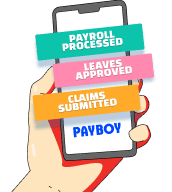For business owners and HR professionals navigating the intricate landscape of employee benefits, understanding annual leave encashment is crucial. Dive into the depths of this essential policy, discovering how to calculate it, whether it's tied to basic or gross salary, and its implications on CPF contributions. We'll also weigh the pros and cons, helping you make informed decisions on whether to include this leave encashment option in your leave policy. Let’s get started!
What is annual leave encashment?
Annual leave encashment is the process by which an employee receives money in exchange for unused annual leave. This means that instead of taking time off, employees may receive financial compensation for the leave days they haven't used.
Note: Employers should check the employment contract to determine how such leave should be handled (encashed, carried forward, or forfeited) if:
- the number of days of unused annual leave exceeds the statutory entitlements, or
- employees are not covered under Part IV of the Employment Act
Tip: Find out more about annual leave entitlements with our guide on “Annual leave in Singapore - What every employer must know”
How is leave encashment calculated?
According to the Ministry of Manpower (MOM), the formula for leave encashment is as follows:
(12 months x Monthly basic or gross rate of pay) / (52 weeks x Average working days per week) x (Number of unused leave days)
Example:
The employee works 5 days per week and earns $5,000 per month. This employee had 10 unused leave days.
Applying the formula, we have:
(12 x $5,000) / (52 x 5) x 10 = $2,307.69
Therefore, the leave encashment amount would be approximately $2,307.69.
Tip: Using Payboy’s leave management module, you can easily calculate MOM-based leave encashment to improve efficiency and compliance. Check out our comprehensive guide on how Payboy calculates leave encashment!
Is leave encashment based on a basic or gross salary?
The calculation of leave encashment can vary depending on the company's policies and guidelines. Therefore, leave encashment can be calculated based on either the employee's basic or gross salary.
It's important to note that some companies might:
- Include certain allowances in the calculation.
- Have specific formulas or caps for encashment amounts that differ from the MOM guidelines.
- Only allow leave encashment under certain circumstances, like resignation or termination.
Tip: Learn the difference between gross and basic salary with “Gross salary: A guide for employers in Singapore”!
Is leave encashment subject to CPF contribution?
Leave encashment is considered part of additional wages and is subject to CPF contributions for both the employer and employee.
Here are two free calculators we have created for you to calculate CPF contributions for additional wages with ease:
Tip: Check out our blog on “CPF guide for employers” for the most recent contribution rates and answers to frequently asked questions.
How is leave encashment on resignation calculated?
Employees can either encash or clear their annual leave if their employment is terminated.
If unused leave is encashed, it should be calculated at the gross rate of pay based on their most recent drawn salary. However, if an employee is terminated for misconduct, any unused leave will be forfeited.
The MOM formula for leave encashment on resignation is as follows:
(12 months x Monthly gross rate of pay) / (52 weeks x Average working days per week) x (Number of unused leave days)
Example:
The employee works 5 days per week and earns $3,500 per month. On resignation, this employee still has 8 unused leave days.
Applying the formula, we have:
(12 x 3,500) / (52 x 5) x 8 = 1,292.31
Therefore, the leave encashment amount on resignation would be approximately $1,292.31.
Tip: Check out our guide on how Payboy can help you simplify the process of cashing out resigned employees' leaves.
What are some pros and cons of allowing employees to encash their annual leave?
Allowing employees to encash their annual leave is a complex decision with benefits and drawbacks. Here are some pros and cons that employers can consider:
Pros of allowing employees to encash annual leave
1. Increased financial flexibility: Offering the option to encash leave provides flexibility to employees who might prefer additional income over taking time off, which can be helpful for financial needs or emergencies.
2. Greater control over work-life balance: Encashed leave allows employees to decide how much time they want to take off and how much they want to get paid for. This can help them maintain a healthy work-life balance and enhance their well-being.
3. Reduced leave liability: Some employees may feel pressure to take all of their allotted leave days, even if they don't need or want to. Encashment can help alleviate this pressure by allowing employees to take leave only when they truly need it.
4. Improved employee morale: Annual leave encashment can be seen as a perk by employees, which can boost morale and improve their retention.
Cons of allowing employees to encash annual leave
1. Insufficient rest and rejuvenation: Encashing leave might discourage employees from taking necessary breaks, leading to burnout and decreased productivity in the long run.
2. Increased financial liability Encashing accumulated leave can result in increased financial liabilities for the company. This may be a concern for businesses, especially during challenging economic times or when profit margins are tight.
Should employers allow employees to encash annual leave?
The decision to allow employees to encash annual leave is subjective and depends on various factors, including the company's financial considerations, and the overall well-being of the workforce. Here are key points to help you make an informed decision:
- Financial capacity: Assess the company's financial capacity to manage potential increases in financial liabilities resulting from leave encashment.
- Employee preferences: Survey employee preferences to understand whether they value leave encashment or prefer other benefits like additional time off or wellness programs.
- Leave policy clarity: Clearly communicate the terms and conditions of leave encashment to avoid misunderstandings and ensure consistent application.
- Balancing workforce needs: Find a balance that meets both the needs of the organisation and the well-being of employees.
Ultimately, the decision to allow leave encashment should be well-considered, taking into account the unique circumstances and priorities of your organisation.
How to include leave encashment in leave policy?
Incorporating leave encashment into a company's leave policy requires thoughtful consideration and clear communication. Here are some friendly tips on how to include leave encashment in the leave policy:
1. Define encashment eligibility
- Who can encash: This may include criteria such as employee categories (e.g., full-time vs. part-time), minimum tenure, full utilisation of annual leave, or specific circumstances.
- When they can encash: Consider specific periods, such as year-end or only after exceeding accrued leave limits.
- How much they can encash: Establish maximum limits on the number of leave days that can be encashed within a specified period to avoid excessive encashment requests.
2. Determine the calculation method
- Basic salary or gross salary: Choose the basis for calculating the encashment amount.
- Formula or guidelines: Establish a clear formula or reference MOM guidelines for Singaporean companies.
- Tax implications: Clearly communicate any tax implications associated with leave encashment.
- Potential modifiers: Consider whether to pro-rate based on remaining contract or exclude specific leave types.
3. Include a request and approval process
- Application procedure: Outline a clear process for employees to request leave encashment. This should include the submission of a formal request and any supporting documentation required.
- Managerial approval: Define approval hierarchy and criteria for granting encashment requests.
- Payment timeline: Set a timeline for processing and disbursing the encashment amount.
4. Consider company culture and communication
- Cultural fit: Adapt the policy to your company culture and ensure it balances employee needs with potential impacts on workload and productivity.
- Clear communication: Communicate the leave encashment policy clearly through employee handbook, website, or training sessions.
5. Regularly review and update
Periodically review and update the leave encashment policy to ensure that it remains aligned with the company's evolving needs and industry best practices.
By incorporating these considerations into your leave policy, you can create a well-defined and transparent framework for leave encashment that benefits both the organisation and its employees.
Simplify leave encashment calculations with Payboy’s leave management system!
Small and medium-sized enterprises (SMEs) often find leave management to be a pain point, and we can understand why:
- SMEs don’t have as many HR resources as larger businesses. As a result, they often have to rely on manual leave processes, which can be both time-consuming and error-prone.
- SMEs often have a more limited pool of employees to choose from when someone goes on leave. This can lead to disruptions in workflow and decreased productivity.
If leave isn't managed properly, it can have a negative impact on productivity and morale. Therefore, good HR software is an essential tool for any business that wants to stay on top of its leave entitlements and ensure its employees are getting the rest they deserve.
Here are some benefits of using our leave management module to manage all leave-related matters including leave encashment!
Manage leaves digitally
Our leave management module is designed to streamline the leave management process, making it easy for employees to apply for leave and check leave balances, as well as for employers to approve and manage leave requests.
Employees can also easily submit supporting documents or certificates via the mobile app, so that all the documents are stored in a central database. No more missing documents!
Sync seamlessly with Shift Scheduling and Payroll Processing modules
Shift scheduling and payroll calculation can be time-consuming and stressful while you are managing different leave types and requests. With Payboy HR software, when leaves are approved, the employee’s availability will be automatically updated in the Shift Scheduling module, and any encashed or unpaid leave will be calculated in the Payroll Processing module.
Customise the leave policy that best fits your business needs
We'll provide you with a MOM-compliant setup to start with, but we are also ready to assist you in customising your leave policy to fit your business requirements. Check out how to customise settings for each leave type with Payboy!
Our Payboy Support Centre also helps to address most of the FAQs regarding other statutory leave entitlements asked by our customers:
Streamline your HR processes with Payboy today!
As a PSG-approved HRMS, Payboy provides a robust system to help you manage your HR tasks so that you can focus on your business and people!
With our wide range of modules, you can customise a solution to meet the specific needs of your business: Payroll Processing | Leave Management | Claims Management | Applicant Tracking | Time Attendance | Shift Scheduling | Appraisal System | Inventory Management | Project Costing | Training Management | Benefits





















